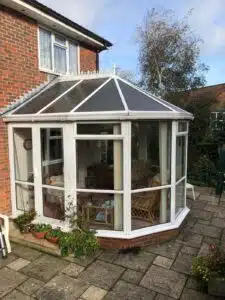Conservatories are a popular addition to homes, offering a bright and airy space that can serve multiple purposes, from a dining room to a cozy reading nook. Traditionally, conservatories are built with a glass roof, letting in plenty of natural light and offering views of the sky. However, many homeowners are now considering a tiled conservatory roof as an alternative. Tiled roofs are being marketed as more energy-efficient, durable, and practical than their glass counterparts. But is a tiled conservatory roof the right choice for you? As a contractor with years of experience working on conservatories, I’ll provide you with a contractor’s perspective to help you weigh the pros and cons.
The Appeal of Tiled Conservatory Roofs
Improved Insulation and Energy Efficiency
One of the primary selling points of a tiled roof for conservatories is its improved insulation. Conservatories, with their large glass panels, can be notoriously difficult to keep warm during the winter and cool in the summer. With a glass roof, you may find that your heating bills skyrocket during colder months as the heat escapes, while in the summer, the space becomes unbearably hot. A tiled roof, on the other hand, offers significantly better insulation, keeping the temperature more stable throughout the year.
The increased insulation also makes a tiled roof more energy-efficient, reducing the need for additional heating and cooling systems. This can be a great benefit if you plan to use your conservatory year-round rather than just as a seasonal space. In fact, many homeowners find that their tiled conservatories feel more like a traditional room in the house, with a level of comfort and energy efficiency that glass simply can’t provide.
Reduced Noise Pollution
Another benefit of a tiled conservatory roof is the reduction in noise. Glass roofs can amplify external noises, whether it’s the sound of rain, wind, or traffic, making the conservatory a noisy space. A tiled roof offers better soundproofing, ensuring that you have a more peaceful and quiet environment. This is especially valuable if you live in a noisy area or enjoy relaxing in your conservatory without the distraction of outside sounds.
Aesthetic Appeal
Tiled roofs also provide a more traditional and refined look compared to glass. While glass roofs can give a conservatory a modern and open feel, they can sometimes look out of place in older homes or homes with more traditional architecture. A tiled roof blends more seamlessly with the rest of your property, giving the entire conservatory a cohesive and timeless look. Many homeowners appreciate the way a tiled roof enhances the overall aesthetic of their home and adds curb appeal.
The Downsides of Tiled Conservatory Roofs
Loss of Natural Light
One of the most significant drawbacks of a tiled roof is the loss of natural light. With a glass roof, your conservatory is flooded with daylight, which can make the space feel bright and open. A tiled roof, while offering many practical benefits, can make the conservatory feel darker. This might not be a problem if you are replacing an existing glass roof with tiles, but it’s important to note that the loss of natural light can change the entire atmosphere of the room. If you’re someone who enjoys a lot of natural sunlight, this could be a dealbreaker for you.
If you’re concerned about losing light, there are hybrid options available. Some contractors can incorporate rooflights or small glass panels into the tiled roof design to allow some light into the space. However, these will still not provide the same level of brightness as a full glass roof.
Higher Upfront Costs
Another consideration when choosing a tiled conservatory roof is the upfront cost. While the long-term savings on energy bills and maintenance might offset the initial price, the installation of a tiled roof can be more expensive than replacing a glass roof. Not only do the materials cost more, but the installation process itself can be more complex. You’ll need to hire a skilled contractor who specializes in this type of roofing, which can also increase the cost.
However, many homeowners find that the investment is worth it, especially when considering the added comfort and functionality that comes with a tiled roof. It’s also worth noting that a tiled conservatory roof can increase the overall value of your home, making it an attractive choice for those looking to sell in the future.
Structural Considerations
While a tiled conservatory roof may seem like an easy upgrade, it’s important to assess whether your existing conservatory structure is suitable for the additional weight. Tiled roofs are significantly heavier than glass roofs, so your conservatory’s frame must be strong enough to support the added weight. In some cases, this may require reinforcement, which could add further to the cost of the project.
As a contractor, I’ve encountered situations where homeowners had to go back to the drawing board after realizing that their conservatory’s structure wasn’t designed to support a tiled roof. It’s essential to get an expert evaluation before making the decision to switch to a tiled roof.
What Is the Installation Process Like?
Planning and Design
Before installing a tiled roof, careful planning is essential. The process starts with a thorough assessment of the conservatory’s current structure and design. Depending on the existing layout and the weight of the new roof, adjustments may need to be made. The roofing materials are chosen, and a detailed plan is drawn up to ensure that the roof will be both functional and aesthetically pleasing.
A good contractor will take into account factors like the conservatory’s position relative to the sun, the style of the house, and your specific needs. They will also help you choose between different types of tiles, from slate to concrete, to achieve the desired look.
Removal of Existing Roof
In most cases, the first step in the installation process is removing the existing glass roof. This can be a labor-intensive process, particularly if the conservatory is older and the glass has become brittle over time. Once the glass panels are removed, the frame is inspected for damage and reinforced if necessary.
Installation of the Tiled Roof
Once the frame is ready, the tiled roof is installed. This involves laying down the necessary supports, followed by the tiles themselves. Depending on the type of tiles you’ve chosen, the process can take anywhere from a few days to a week or more. During this time, the space may be temporarily unavailable, but the end result will be a conservatory that feels more like an extension of your home.
Final Considerations: Is It Right for You?
Choosing a tiled conservatory roof ultimately comes down to your personal preferences, budget, and how you intend to use the space. If you’re looking for a more energy-efficient, durable, and quieter space that can be used year-round, a tiled roof may be the right choice. The additional insulation and soundproofing can make the conservatory more comfortable and functional, especially during the colder months. However, if you value natural light and an open, airy feel, you may find that the loss of sunlight from a tiled roof is a significant drawback.
From a contractor’s perspective, I can confidently say that the decision to install a tiled conservatory roof is one that requires careful consideration. It’s important to assess the structural integrity of your conservatory, factor in the cost, and weigh the benefits against the drawbacks. With the right planning and the help of an experienced contractor, a tiled conservatory roof can be a great addition to your home, offering both practical benefits and a refined, timeless aesthetic.




